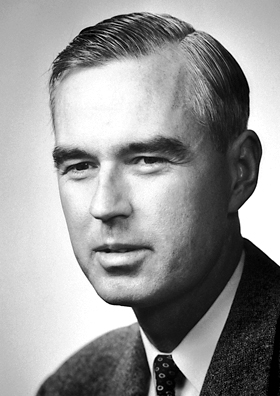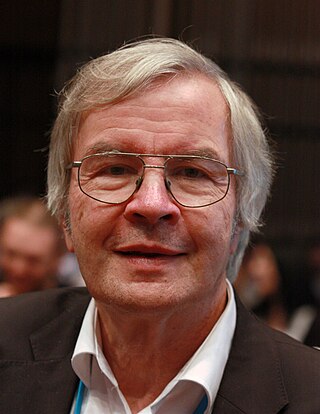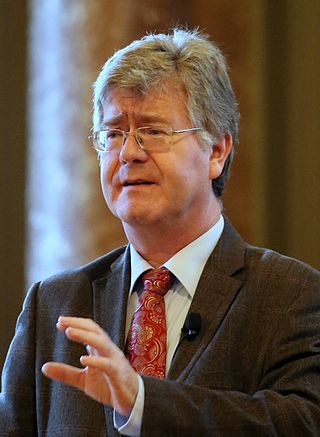External links
- Faculty page at Princeton University.
- Group photograph (This photograph taken at Lasers '92 includes, right to left, Marlan Scully, Willis E. Lamb, John L. Hall, and F. J. Duarte)
Marlan O. Scully | |
|---|---|
| Born | August 3, 1939 Casper, Wyoming, U.S. |
| Nationality | American |
| Alma mater | Rensselaer Polytechnic Institute Casper College University of Wyoming Yale University |
| Known for | Quantum optics Laser physics |
| Awards | Adolph E. Lomb Medal (1970) Elliott Cresson Medal (1990) Charles Hard Townes Award (1998) Quantum Electronics Award (2003) Arthur L. Schawlow Prize (2005) Herbert Walther Award (2011) Frederic Ives Medal (2012) |
| Scientific career | |
| Fields | Physics |
| Institutions | Baylor University Texas A&M University Princeton University Yale University MIT University of Arizona University of New Mexico Max Planck Inst. of Quantum Optics |
| Thesis | Quantum theory of an optical maser (1967) |
| Doctoral advisor | Willis Lamb |
| Doctoral students | Julio Gea-Banacloche Patrick A. Lee Mikhail Lukin Wolfgang P. Schleich Eric Van Stryland |
Marlan Orvil Scully (born August 3, 1939) is an American physicist best known for his work in theoretical quantum optics. He is a professor at Texas A&M University and Princeton University. [1] Additionally, in 2012 he developed a lab at the Baylor Research and Innovation Collaborative in Waco, Texas. [2]
He has authored over 700 scientific articles, as well as standard textbooks such as Laser Physics (with W. Lamb and M. Sargent) and “Quantum Optics” (with M. S. Zubairy). [3] [4]
Scully was born in Casper, Wyoming, where he attended public schools including Casper College, and finished his undergraduate studies at the University of Wyoming and Rensselaer Polytechnic Institute. He received his PhD under the guidance of Willis Lamb at Yale University in 1965. [3]
After completing his graduate work at Yale University, Scully became an instructor at Yale and then proceeded to become an assistant professor at MIT, where he received early promotion to associate professor and moved to the University of Arizona to become professor before age 30. While there, he worked with Willis Lamb, Peter Franken, and others to build the Optical Sciences Center there. In 1980, he took a joint position between the Max Planck Institute für Quantenoptik and the University of New Mexico as distinguished professor. In 1992, [5] he moved to Texas A&M, where he is now Burgess Distinguished Professor of Physics, holds the TEES Distinguished Research chair, and is director of the Center for Theoretical Physics and the Institute for Quantum Studies. In 2003, he was appointed visiting professor at Princeton University. In 2005, he accepted a joint professional appointment between Texas A&M and Princeton Universities. [3]
The Scully-Lamb quantum theory of the laser was the first theoretical treatment which yielded the laser photon statistics, the laser linewidth, and all higher order photon correlations. It was later extended to explain behavior of the single photon maser. Most recently, Scully and coworkers have shown that the laser master equation analysis also provides a good quantitative description of fluctuations in the Bose–Einstein condensate.[ citation needed ]
The foundation of quantum mechanics is another area which Scully has made pioneering contributions. Aharonov and Zubairy in their 2005 Science article on "Time and the Quantum" describe one facet of his work as follows:
"The quantum eraser effect of Scully and Drühl dramatically underscores the difference between our classical conceptions of time and how quantum processes can unfold in time. Such eyebrow-raising features of time in quantum mechanics have been.. . described ‘as one of the most intriguing effects in quantum mechanics’.. . The quantum eraser concept has been studied and extended in many different experiments and scenarios, for example, the entanglement quantum eraser, the kaon quantum eraser, and the use of quantum eraser entanglement to improve microscopic resolution." [6]
A rather unorthodox feature of his career is his strong combination of theoretical and experimental science. For example, Scully and colleagues were the first to make lasers oscillate without population inversion and have extended the coherent Raman spectroscopy techniques to detect anthrax type endospores. In addition, Scully is long time cattle rancher known for his research in the United States and abroad, e.g., Mongolia, into beef cattle production. This unlikely combination of activities and interests has resulted in his being dubbed the "quantum cowboy."[ citation needed ] In addition to his seven US Patents in laser physics, he holds a US Patent (5,198,222) titled "Time Release Bolus," which is a device for slowly delivering medicine or nutrients into the stomach of a cow.[ citation needed ]
Scully is a member of the National Academy of Sciences, the American Academy of Arts & Sciences, the Academia Europaea, and the Max Planck Society. He has also received numerous awards including the Adolph E. Lomb Medal of the OSA in 1970, [7] the Elliott Cresson Medal of the Franklin Institute in 1990, the Charles Hard Townes Award of the OSA in 1998, [8] the Quantum Electronics Award of IEEE in 2003, [9] a Guggenheim Fellowship, the Alexander von Humboldt Distinguished Faculty Prize, the APS Arthur L. Schawlow Prize in 2005, [10] and has been appointed to a Harvard Loeb Lectureship. [3] [4] [11] [12] In 2011, Scully was honored with the Herbert Walther Award [13] and in 2012 with the Frederic Ives Medal of the OSA. [14] In December 2016, he has been elected as a Foreign Member Of Russian Academy of Sciences. [15] In 2021, he was elected as a foreign member of the Chinese Academy of Sciences with a Chinese name 司嘉理 (pinyin :Sī Jiālǐ). [16]
His wife Judith Bailey Scully and he have three sons: James, an American Airline captain; Robert, a writer and Caterpillar diesel mechanic; and Steven, an electrical engineer with Dallas Semiconductor. Rob (with an introduction by his father) wrote a book entitled “The Demon and the Quantum: From the Pythagorean Mystics to Maxwell's Demon and Quantum Mystery” which was published by Wiley-VCH in October 2007. The book is directed toward the layperson as well as the professional physicist and examines the connection between Maxwell's Demon and the role of the observer and quantum eraser.[ citation needed ]Marlan is a Christian. [17]

Arthur Leonard Schawlow was an American physicist who, along with Charles Townes, developed the theoretical basis for laser science. His central insight was the use of two mirrors as the resonant cavity to take maser action from microwaves to visible wavelengths. He shared the 1981 Nobel Prize in Physics with Nicolaas Bloembergen and Kai Siegbahn for his work using lasers to determine atomic energy levels with great precision.

Willis Eugene Lamb Jr. was an American physicist who won the Nobel Prize in Physics in 1955 "for his discoveries concerning the fine structure of the hydrogen spectrum." The Nobel Committee that year awarded half the prize to Lamb and the other half to Polykarp Kusch, who won "for his precision determination of the magnetic moment of the electron." Lamb was able to precisely determine a surprising shift in electron energies in a hydrogen atom. Lamb was a professor at the University of Arizona College of Optical Sciences.
Quantum optics is a branch of atomic, molecular, and optical physics dealing with how individual quanta of light, known as photons, interact with atoms and molecules. It includes the study of the particle-like properties of photons. Photons have been used to test many of the counter-intuitive predictions of quantum mechanics, such as entanglement and teleportation, and are a useful resource for quantum information processing.

Gérard Albert Mourou is a French scientist and pioneer in the field of electrical engineering and lasers. He was awarded a Nobel Prize in Physics in 2018, along with Donna Strickland, for the invention of chirped pulse amplification, a technique later used to create ultrashort-pulse, very high-intensity (petawatt) laser pulses.

Theodor Wolfgang Hänsch is a German physicist. He received one-third of the 2005 Nobel Prize in Physics for "contributions to the development of laser-based precision spectroscopy, including the optical frequency comb technique", sharing the prize with John L. Hall and Roy J. Glauber.
Leonard Mandel was an American physicist who contributed to the development of theoretical and experimental modern optics and is widely considered one of the founding fathers of the field of quantum optics. With Emil Wolf he published the highly regarded book Optical Coherence and Quantum Optics.
In quantum mechanics, a quantum eraser experiment is an interferometer experiment that demonstrates several fundamental aspects of quantum mechanics, including quantum entanglement and complementarity. The quantum eraser experiment is a variation of Thomas Young's classic double-slit experiment. It establishes that when action is taken to determine which of 2 slits a photon has passed through, the photon cannot interfere with itself. When a stream of photons is marked in this way, then the interference fringes characteristic of the Young experiment will not be seen. The experiment also creates situations in which a photon that has been "marked" to reveal through which slit it has passed can later be "unmarked." A photon that has been "unmarked" will interfere with itself once again, restoring the fringes characteristic of Young's experiment.

Yakir Aharonov is an Israeli physicist specializing in quantum physics. He has been a Professor of Theoretical Physics and the James J. Farley Professor of Natural Philosophy at Chapman University in California since 2008. He was a distinguished professor in the Perimeter Institute between 2009-2012 and is a professor emeritus at Tel Aviv University and at University of South Carolina. He is president of the IYAR, The Israeli Institute for Advanced Research.

Peter Zoller is a theoretical physicist from Austria. He is professor at the University of Innsbruck and works on quantum optics and quantum information and is best known for his pioneering research on quantum computing and quantum communication and for bridging quantum optics and solid state physics.
Herbert Walther was a leader in the fields of quantum optics and laser physics. He was a founding director of the Max Planck Institute of Quantum Optics (MPQ) in Garching, Germany. He also was Chair of Physics at Ludwig Maximilian University of Munich. He is primarily known for his experimental work on cavity quantum electrodynamics as well his groundbreaking work on the ion trap.
A photo-Carnot engine is a Carnot cycle engine in which the working medium is a photon inside a cavity with perfectly reflecting walls. Radiation is the working fluid, and the piston is driven by radiation pressure.

David Jeffrey Wineland is an American Nobel-laureate physicist at the National Institute of Standards and Technology (NIST). His work has included advances in optics, specifically laser-cooling trapped ions and using ions for quantum-computing operations. He was awarded the 2012 Nobel Prize in Physics, jointly with Serge Haroche, for "ground-breaking experimental methods that enable measuring and manipulation of individual quantum systems".
Muhammad Suhail Zubairy, HI, SI, FPAS, is a University Distinguished Professor as of 2014 in the Department of Physics and Astronomy at the Texas A&M University and is the inaugural holder of the Munnerlyn-Heep Chair in Quantum Optics.
Berthold-Georg Englert is Provost's Chair Professor at the National University of Singapore, and Principal Investigator at the Centre for Quantum Technologies. In 2006, he was recognized for outstanding contributions to theoretical research on quantum coherence. Englert's principal research interests concern applications in quantum information science, but he is also known for his early work on quantum optics together with Marlan Scully at Texas A&M University.

The Einstein Prize for Laser Science was a recognition awarded by the former Society for Optical and Quantum Electronics and sponsored by the Eastman Kodak Company. The prize, awarded in the 1988–1999 period, consisted of a 3-inch brass medal including Einstein's image and a depiction of a two-level transition including the A and B coefficients. Recipients of the prize include:

Wolfgang P. Schleich is professor of theoretical physics and director of the quantum physics department at the University of Ulm.
Mikhail Lukin ; born 10 October 1971) is a Russian theoretical and experimental physicist and a professor at Harvard University. He was elected a member of the National Academy of Sciences in 2018.
Lasing without inversion (LWI), or lasing without population inversion, is a technique used for light amplification by stimulated emission without the requirement of population inversion. A laser working under this scheme exploits the quantum interference between the probability amplitudes of atomic transitions in order to eliminate absorption without disturbing the stimulated emission. This phenomenon is also the essence of electromagnetically induced transparency.

Jun Ye is a Chinese-American physicist at JILA, National Institute of Standards and Technology, and the University of Colorado Boulder, working primarily in the field of atomic, molecular and optical physics.
Olga Anatolevna Kocharovskaya is a distinguished professor of physics at Texas A&M University, known for her contributions to laser physics, quantum optics and gamma ray modulation.